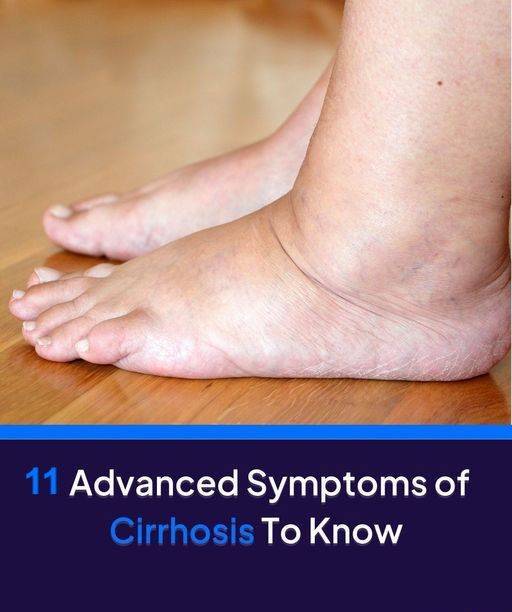Cirrhosis is a chronic liver condition in which healthy liver tissue is gradually replaced by scar tissue, ultimately impairing the liver’s ability to function properly. Early detection of cirrhosis can significantly improve outcomes by allowing for timely intervention and treatment. In this article, we explore 11 early and advanced symptoms of cirrhosis you should be aware of, helping you recognize potential warning signs and understand the progression of the disease.
Persistent Fatigue and Weakness
One of the most common early symptoms of cirrhosis is an overwhelming sense of fatigue. Many individuals find that they are constantly tired, regardless of how much rest they get. This persistent fatigue occurs because the damaged liver is less efficient at processing nutrients and detoxifying the body, leaving you feeling drained and weak throughout the day.

Loss of Appetite and Unexplained Weight Loss
A decline in appetite is another early indicator of liver dysfunction. As cirrhosis develops, many people experience a reduced desire to eat, leading to unintended weight loss. This can result from the liver’s diminished ability to metabolize food and absorb essential nutrients, further contributing to a general state of malnutrition.
Jaundice: Yellowing of the Skin and Eyes
Jaundice is a hallmark of more advanced liver disease and occurs when the liver is unable to effectively process bilirubin, a byproduct of red blood cell breakdown. The accumulation of bilirubin in the bloodstream leads to a yellowing of the skin and the whites of the eyes. This symptom is often the first visual sign that prompts individuals to seek medical attention.
Abdominal Pain and Swelling (Ascites)
As cirrhosis worsens, scar tissue can impede the normal flow of blood through the liver, leading to portal hypertension—a condition that causes fluid to accumulate in the abdomen, known as ascites. This fluid buildup can result in significant abdominal distension, discomfort, and even pain, as the body struggles to accommodate the excess fluid.
Swelling in the Legs and Ankles (Edema)
In addition to ascites, many people with cirrhosis develop edema, or swelling, in their legs, ankles, and feet. The impaired liver function leads to imbalances in the body’s fluid regulation, causing fluid retention in the lower extremities. This swelling can be both uncomfortable and a noticeable sign of underlying liver problems.
Easy Bruising and Bleeding
The liver plays a critical role in producing proteins necessary for blood clotting. When cirrhosis interferes with this process, individuals may notice that they bruise more easily or experience prolonged bleeding even from minor cuts. This symptom is particularly concerning as it indicates a significant decline in liver function and the body’s ability to repair itself.
Cognitive Changes and Confusion (Hepatic Encephalopathy)
As toxins build up in the bloodstream due to the liver’s reduced detoxification capacity, they can begin to affect brain function. Early signs of hepatic encephalopathy include difficulty concentrating, confusion, and forgetfulness. In severe cases, this can progress to disorientation and even coma, making it a critical symptom that requires immediate medical intervention.

Spider Angiomas
Spider angiomas are small, red, spider-like blood vessels that appear on the skin, often on the face, neck, and upper chest. These are caused by hormonal imbalances associated with liver disease, particularly the elevated estrogen levels that occur when the liver can no longer effectively break down this hormone. Their presence is a telltale sign of advanced liver dysfunction.
Persistent Itching (Pruritus)
Chronic itching can occur in individuals with cirrhosis as bile salts accumulate in the skin. This pruritus is not only uncomfortable but can also lead to secondary skin infections from repeated scratching. Persistent itching is a common complaint and may serve as an early warning sign that liver function is compromised.
Nausea and Vomiting
Many people with cirrhosis experience gastrointestinal discomfort, including frequent nausea and episodes of vomiting. This can result from the liver’s inability to manage toxins effectively, causing digestive disturbances that exacerbate overall feelings of illness and fatigue.
Changes in Urine and Stool Color
Alterations in the color of urine and stool are important indicators of liver dysfunction. Dark urine may be a sign that bilirubin is being excreted in high amounts, while pale or clay-colored stools suggest that bile flow from the liver is obstructed. These changes often accompany other symptoms and signal that liver function is significantly impaired.
Understanding these 11 symptoms is crucial, as they range from early indicators—such as fatigue, loss of appetite, and mild nausea—to more advanced signs like jaundice, ascites, and cognitive changes. If you or a loved one experiences several of these symptoms, it is important to consult a healthcare professional promptly. Early diagnosis and intervention can help manage the progression of cirrhosis and improve quality of life through appropriate treatments, lifestyle changes, and, in some cases, medical procedures.
By staying informed and vigilant about the symptoms of cirrhosis, you empower yourself to seek help early, potentially slowing the disease’s progression and protecting overall health. Remember, while many of these symptoms can be linked to cirrhosis, they may also be indicative of other health conditions, making professional evaluation essential for an accurate diagnosis.

















